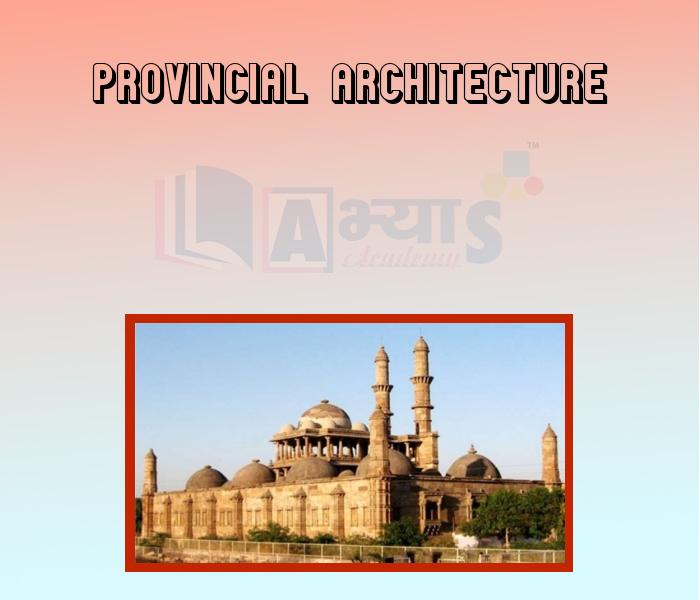Provincial Architecture












Provincial Architecture
Provincial Architecture: The Provincial Style of architecture encompasses the trends and developments noticed in different provincial capitals in India, but specifically in Punjab (1150-1325 A.D.), Bengal (1203-1573 A.D.), Gujarat (1300-1572 A.D.), Jaunpur (1376-1479 A.D.), Malwa (1405-1569 A.D.), Deccan (1347-1617 A.D.), Bijapur (1490-1656 )
The imperial style of the Delhi sultans influenced the architecture of the provinces. But the influence decreased with distance so that the more remote parts reveal more local influences. However, the architecture of Bengal reveals marked Hindu influences. The massive walls and convex roofs and domes typical of Islamic architecture are combined with fine, delicate designs. In Gujarat, many of the structures showed a combination of Hindu and Muslim styles of architecture. Architecture in the Deccan had a definite Persian influence, as many of the rules of the Bahamani Kingdom came from Persia.
The Pandua and Adina mosques are the earliest architectural examples in Bengal .The Tomb of Akhi Surajuddin , the 'Kotwali" Darwaza', the Dakhil Darwaza and the tomb of sultan Jalaluddin Mohammad Shah (1414-1431A.D) Known as the " Eklakhi Tomb', served as prototypes for the subsequent Islamic architecture of Bengal . The other important buildings of Bengal include ' Tantipara' Masjid' (1475 AD) 'Chota sona Masjid ' (1510A.d) and the Qadam-e--Rasool Masjid' (1530A.D)
Students / Parents Reviews [10]
One of the best institutes to develope a child interest in studies.Provides SST and English knowledge also unlike other institutes. Teachers are co operative and friendly online tests andPPT develope practical knowledge also.

Aman Kumar Shrivastava
10thA marvelous experience with Abhyas. I am glad to share that my ward has achieved more than enough at the Ambala ABHYAS centre. Years have passed on and more and more he has gained. May the centre flourish and develop day by day by the grace of God.

Archit Segal
7thI have spent a wonderful time in Abhyas academy. It has made my reasoning more apt, English more stronger and Maths an interesting subject for me. It has given me a habbit of self studying

Yatharthi Sharma
10thBeing a parent, I saw my daughter improvement in her studies by seeing a good result in all day to day compititive exam TMO, NSO, IEO etc and as well as studies. I have got a fruitful result from my daughter.

Prisha Gupta
8thIt was good as the experience because as we had come here we had been improved in a such envirnment created here.Extra is taught which is beneficial for future.

Eshan Arora
8thMy experience with Abhyas academy is very good. I did not think that my every subject coming here will be so strong. The main thing is that the online tests had made me learn here more things.

Hiya Gupta
8thMy experience was very good with Abhyas academy. I am studying here from 6th class and I am satisfied by its results in my life. I improved a lot here ahead of school syllabus.

Ayan Ghosh
8thAbhyas is a complete education Institute. Here extreme care is taken by teacher with the help of regular exam. Extra classes also conducted by the institute, if the student is weak.

Om Umang
10thAbhyas Methodology is very good. It is based on according to student and each child manages accordingly to its properly. Methodology has improved the abilities of students to shine them in future.

Manish Kumar
10thIt was a good experience with Abhyas Academy. I even faced problems in starting but slowly and steadily overcomed. Especially reasoning classes helped me a lot.
